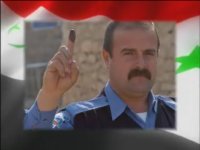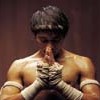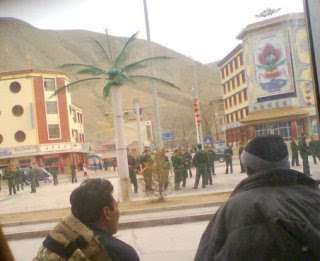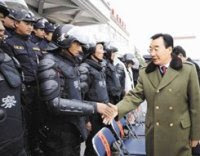Agam's Gecko


Friday, March 06, 2009
TIBETANS DEMAND RELIGIOUS RIGHTS; CHINA INSISTS ALL IS WELL
| T |
he Monlam Chenmo Great Prayer Festival has been at the centre of recent and continuing protest in Tibet. Prohibitions of Monlam ceremonies have sparked outrage in several areas, leading to further increases in repressive measures, and even more resentment by Tibetans.
The Monlam Chenmo tradition was first begun by the founder of the Gelug-pa school of Tibetan Buddhism, Tsongkhapa, in the year 1409 (the same year Ganden Monastery, at the eastern outskirts of Lhasa, was founded). Yes that's right, we have yet another momentous anniversary going on in this anniversary-laden year -- the 600th anniversary of the most important annual religious event for Tibetans. Six complete centuries, and the communist new-comers feel they have the right to ban it.
But that's not all. Tibetans don't necessarily relate to 100-year centuries for their long period time cycles, but they do mark the long periods of the "Jovian" sixty-year cycle (rabjung) -- derived from the 12 animals and 5 elements which combine to denote each year. This cycle repeats every 60 years, which means that 2009 is not only exactly six centuries since Monlam was begun by Tsongkhapa, it is also exactly ten rabjung cycles. I've been informed that the year 1409 was the "Earth Ox" year of the 7th rabjung, and 2009 is the "Earth Ox" year of the 17th rabjung.
Readers can learn a lot more about these time cycles at the wonderful Tibeto-logic blog. It's no wonder the Tibetans are feeling extra annoyed with Chinese interlopers, who now ban them from observing the major milestone Monlam Chenmo this month.
But of course, this isn't the first time. Monlam was banned when the "Great Proletarian Cultural Revolution" swept into Tibet in 1966, and was not permitted again until 1986. Following independence protests in Lhasa in March 1988, Monlam was again banned the following year (wiki has this a bit wrong, I believe).
On Sunday morning March 1 at around 8:00 am local time, the monks of Jonang Sey Thubten Chokgyal Ling Monastery (Ngaba County and Prefecture) reportedly protested after police and officials from their very own "Democratic Management Committee" prevented them from conducting a prayer service for Monlam Chenmo. The order banning the religious ceremony had been issued earlier by the government.
All the monks gradually rose up to protest the order and insisted to observe the prayer service, sources said.Just two days earlier, around 1000 monks at nearby Kirti Monastery had gathered to observe this longstanding Tibetan Buddhist tradition, but were locked out of their main prayer hall -- leading one of their number to self-immolate (see the previous post). Eyewitnesses said the monk was shot by security forces before they extinguished the fire, but the Chinese government has now denied this.
Demanding the release of all the Tibetans who have been arrested since March last year, the monks came out of the prayer hall and started marching towards the main town. But they were stopped on the way by a large number of military personnel.
The Sey Monastery is located only about a kilometre and a half from Kirti Monastery in Ngaba town. Defying the prohibition, the monks went ahead with a prayer on Sunday morning, according to a Tibetan source in contact with the area.
"Right after they started, officials [likely to be members of the work team stationed at the monastery] intervened and stopped the ceremony. The monks asked the officials, 'Allow us to pray 'dukkar' [a precious prayer to remove obstacles] once and we will stop.' They didn’t say anything and the monks continued to pray."Within ten minutes the monks were halted by officials (and possibly also senior monks) calling on them not to proceed, for fear of a violent response from troops. Armed security forces soon arrived at the scene and the monks began to return to their monastery, which was surrounded by armed forces and isolated under a lockdown. An eyewitness told ICT that Chinese troops are conducting manoeuvres in the area close to Sey Monastery.
At some point the monks present stood up and left the prayer hall. According to the same source, there are likely to have been as many as 600 monks. They left the monastery and walked towards Ngaba town, shouting that they should be allowed to observe the Monlam prayer ceremony and calling on the authorities to release prisoners from Ngaba. It is not possible to confirm how many monks protested as sources varied in their accounts of the number of monks who did so.
In response to the large, peaceful showing of dissatisfaction by the monks of Sey Monastery after denial of their religous rights, the Chinese Party Secretary of the ethnically Tibetan Ngaba Prefecture, Shi Jun, came up with a great new spin (which will surely be used again): The monks weren't protesting, they were celebrating. Yeah, that's the ticket.... celebrating.
"Having elected a lama to the post of a monastery administrator ... lamas with the Se Monastery were overjoyed and congratulated the electee on his success," Shi told Xinhua...It's as though Chinese colonial officials are acting as Monty Python's pet shop owner. "The parrot's not dead, he's just restin'! Shagged out after a long squawk, he is. Pinin' for the fjords, that's it. Beautiful plumage, the Norwegian Blue..."
"This was a normal religious activity but had been distorted as 'Tibetan lamas protest' by some foreign media with ulterior motives, we are indignant toward the distorted news reports based on hearsays and are disappointed at those western media," Xinhua quoted him saying, in an English-language report.Communist elites are indignant -- the natives were just celebrating. They were so very happy with the election of their new disciplinarian, that the security forces had to be called to disperse them so they wouldn't get too happy.
The powerless "governor" of the Tibetan "Autonomous" Region (power is held by the Communist Party Secretary, always a Han Chinese) said the reports of expressed Tibetan dissatisfaction were "pure rumour," adding that there will be "no problems" this year in Tibet because the Tibetan people "have confidence in the (Communist) Party and the government."
The ruling Communist Party mouthpiece People's Daily said that these non-existent ongoing troubles in Tibet were actually a western conspiracy against China. Western politicians have plainly declared, said the paper, that "to control Tibet is to control China." Western governments have been stirring up the Tibetans in order to "divert the attention of their own publics," the propaganda rag helpfully added.
Numerous check posts have been installed on major roads, highways, streets and alleyways. There has been intense restriction on the movement of Tibetan people. According to many sources, temporary police and military bases have mushroomed up at important and strategic locations inside Tibet where protests and demonstrations previously took place.New equipment has been issued to security forces in the T-"A"-R, including 63 new combat vehicles, tear gas, riot batons, "laser torches" and "special gloves with sharp nails" (could it mean "barbs" for that all-important secure grip on monks' robes, or are the forces intending to go all Tiger Claw Style on the Tibetans next?). The winter "Strike Hard" campaign continues, both inside and outside the T-"A"-R.
Edward Wong has penetrated the plateau as far as Machu County (Ch: Gansu province) for the New York Times, but was detained by police for 20 hours, and got a look at security arrangements as he and two companions were expelled for their trouble.
"The Tibetan ethnic situation is very serious," said a paramilitary officer after he stopped three foreigners on a snowy mountain road. "Tibetans are causing trouble. This is an extremely sensitive time."The checkpoint was manned by half a dozen paramilitary People's Armed Police, who said their unit had guarded the "Bird's Nest" during the Olympics. They said they had been deployed into Kanlho Prefecture last month, and that their mission included keeping foreigners out.
Wong says they entered southern Kanlho by driving past several unmanned checkpoints, but doesn't say from which direction. It's unlikely they could have entered from Ngaba, and probably drove south from Rebkong on the Qinghai side and then, into Machu County. The foreigners were taken first to Machu town and on to Tsoe City (Ch: Hezuo) for interrogation, before being forced to drive up to the Gansu provincial capital Lanzhou for a flight to Beijing.
During the day, policemen or soldiers stand on street corners wearing helmets and green coats and carrying riot shields. The main road leading through town is watched by officers armed with assault rifles standing at checkpoints. The sound of troops' drilling can be heard in the early morning hours — louder than any chanting from monks...And what a sight that was (captured on film by a Canadian film crew), Tibetans on foot and horseback charging through the town ("rampaging" is a bit strong, I think) and lowering the PRC flag to replace it with their very own national flag.
Farther north, in Hezuo, the seat of Gannan [Tib: Kanlho] Prefecture, the signs of tension were just as clear. In the town's main traffic circle, the authorities had set up a circular sandbag emplacement overseen by a half-dozen officers, resembling a scene in a war zone. It was just south of Hezuo where nomads on horses and thousands of others rampaged through a schoolyard last year.
During his detention while he awaited expulsion, Wong was told by a local foreign affairs official that there was no problem at all. "There's no ethnic conflict here. Look in the streets — everything is peaceful here. The Chinese, Tibetan and Hui people all get along."
I wonder why Wong didn't ask, "If there's no conflict and everything is so peaceful, why am I being expelled?"
In a report I'd missed last month, NBC producer Adrienne Mong reported on the latest stage-managed "media tour" of Tibet (by invitation only), and discovered the inordinate skill of Chinese officials to rattle off statistics. Answers to questions about arrested monks and monastery populations were far less precise. Her guide at Drepung Monastery in Lhasa, the deputy director of the monastery's "Democratic Management Commitee" Ngawang Choetsen, thought that there were "around 500" monks in residence -- but wasn't quite sure. Many dozens of Drepung monks were known to have been arrested last year. Some remain missing.
Apart from Ngawang and one or two other monks accompanying him, there were no others to interview. They made apologetic excuses when we asked about the whereabouts of the other 500-odd monks, saying they were scattered around the premises, resting or eating lunch.Ngawang admitted that the number of monks at Drepung had declined since last year, and later he acknowledged that "three or four" monks had been involved in protests. When asked what had happened to them, he first replied that, "They just left the monastery." A little later when pressed on their fate, he said, "They have been dealt with according to the procedure of the law."
At the Jokhang Temple the journalists were assured that the usual compliment of 117 resident monks were all present, but the journalists were not allowed to see any of them. Of course, the group of lamenting Jokhang monks (captured on video last year in an embarrassing security lapse, during yet another staged "media tour") were on the reporters' minds. After pressing the officials on the fate of those monks who seized that opportunity to speak out, a quiet 27 year old monk named Norgyal was presented to them.
Naturally enough, Norgyal told the journalists exactly what the CCP wanted them to hear. He had been "misled," he said, and no longer felt the way he did last year.
There are a few bits of good information contained in the story however.
Locals told us that for our visit, officials had hidden hundreds of paramilitary police who had been keeping order in Lhasa for months. It was the type of large-scale stage-management of reality I thought had been abandoned along with Maoism.Surely the authorities must be taking tips from Monty Python -- first it was the "Dead Parrot" sketch, now it's the "How Not to be Seen" sketch (hint: don't stand up).
"It's amazing. The day before you arrived, Lhasa became suddenly peaceful again," quipped one taxi driver.
And as we were hurried through the halls of Lhasa's monasteries I asked to meet some rank-and-file monks, the originators of many recent protests in Tibet, but their red-robed superiors said they were locked away in study or otherwise unavailable. A colleague then stumbled across a group of them cooking nearby, but was hurriedly ushered away.She came away from the four-day trip to Lhasa none the wiser as to the real opinions of regular people. "It's difficult here. We don't dare talk," was the best she could get.
State-run Tibetan dance troupes have been ordered to tour towns and villages in Kardze Prefecture, but the performances have not been well-received, residents have told Radio Free Asia. These groups are well paid, and many of the performers are the children of government officials (but in every case, led by Han Chinese).
Each group was escorted by People’s Armed Police officers and official reporters, travelling in three vehicles, the man [a local resident] said, describing the response by local Tibetans as "very cold."At the Rongpa Tsal subdistrict, near the Thargyal Monastery, and at the Lopa subdistrict, the arrival of a performers' group was anticipated in advance.
"Despite Chinese insistence and threats, hardly any Tibetans attended the officially orchestrated shows," he said, speaking on condition of anonymity.
"Before the performance group arrived, hundreds of posters were put up urging Tibetans not to attend the shows," the source said...The posters also urged continued resistance and called for Tibetan independence. A duty officer at the Kardze PSB told the broadcaster that the performances had gone ahead as planned, and were a "success." However, after these successes, performances at smaller towns and villages were cancelled.
"In some of the posters, the Chinese authorities were threatened with violent retaliation for their crackdowns on peaceful Tibetans," the source said.
RFA also reports that two women, Buddhist nun Pema Yangdzom, 22, and a girl whose name and age are unknown, mounted separate solo protests at the Kardze PSB station yesterday. Pema's uncle, Yeshe Dorje, has been in contact with family members in Kardze.
"My niece protested at around 10:20 a.m. and was quickly taken away by Chinese police," Yeshe Dorje said, citing information from local family members.Chinese officials are constantly squawking that the vast majority of Tibetans have no patriotic feelings for their long lost country and no interest in its former head of state, their spiritual leader, His Holiness Dalai Lama. I don't believe them.
"The other young girl appeared at the same place in the afternoon around 1:00 p.m. and protested. She too was taken away."
"He's much more important to us than the president," added Wenden, who like many Tibetans goes only by one name, dismissively referring to President Hu Jintao.See what those bare hands are up against in this RFA pictorial of the Chinese forces swarming Labrang.
"Please tell the world how much we love our Dalai Lama."
[...]
"The Dalai Lama is our sun," said Sonor, a government worker from the Qinghai-Tibet border.
"The Chinese are very bad. Not only do they kill our people, they kill their own, like in 1989," he said...
"They come here with guns," Sonor added. "How can we fight back? We have nothing but our bare hands."
.











 Our way of saying "thanks" in the Thai way. Here a nak muay Thai (kickboxer) offers respect and thanks for his teacher (wai khru) before a match. This is our local variation on the ubiquitous "hat tip" used in general blog culture.
Our way of saying "thanks" in the Thai way. Here a nak muay Thai (kickboxer) offers respect and thanks for his teacher (wai khru) before a match. This is our local variation on the ubiquitous "hat tip" used in general blog culture.








